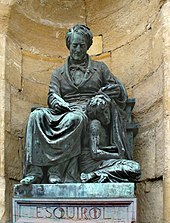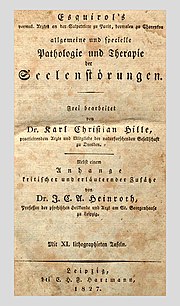Jean Étienne Esquirol
Jean Étienne Dominique Esquirol (born January 4, 1772 in Toulouse , † December 12, 1840 in Paris ) was a French psychiatrist .
Life
Jean Étienne Esquirol studied theology in Toulouse at the “ Collège de l'Esquile ” run by the doctrinaires and then in Paris at the St. Sulpice seminary . When the same closed during the French Revolution , he returned to Touluse and decided to study medicine. In 1794 he was sent to the military hospital in Narbonne as a student . He then studied medicine in Montpellier . In 1799/1800 he opened a private institute for the treatment of the mentally ill. After he had received his medical doctorate in Paris in 1805, he visited all psychiatric hospitals in France in 1808 and then in 1811 was "intern" with Philippe Pinel at the Hôpital de la Salpêtrière in Paris. In 1814 he made another inspection tour to all psychiatric hospitals in France. In 1814 he became a member of the Legion of Honor . In 1817 he began to give clinical lectures on diseases of the mind and psychology. In 1818 he arranged for the appointment of a commission to investigate and stop the abuses in the psychiatric clinics .
In 1823 Esquirol became the university's inspector general. In 1826 he followed Antoine-Athanase Royer-Collard as chief physician in the Charenton hospice . As a result of the July Revolution of 1830 , Esquirol lost his public offices and from then on devoted himself almost exclusively to work in the Charenton hospice, which became a role model.
His tomb is in the Père Lachaise cemetery .
plant
Esquirol took up the concept of mania sans delire of his teacher Philippe Pinel , whom he had joined in Paris in 1799 and with whom he jointly ran the Salpêtrière from 1810 to 1826, and developed his doctrine of monomania from it . He also relied on the concept of "pathomania" published in 1816 by the Geneva doctor André Matthey .
By monomania, Esquirol understood an isolated (partial) disorder of mental functions, which, however, leaves other mental areas unaffected. A further development of the monomania theory was carried out by Charles Chrétien Henry Marc .
In 1815 he introduced the terms “ grand mal ” and “ petit mal ” (originally used by patients) and the term “symptomatic epilepsy ” into medical nomenclature. In 1838, a bill introduced by Esquirol was passed which was the first comprehensive law regulating the insane in Europe.
In his publication Des maladies mentales (1838) he laid the foundation for the classification and psychopathological description of hallucinations . Esquirol was instrumental in the research and treatment of mental illness.
In therapy, Esquirol was rather skeptical of the then common treatments with emetics, bloodletting and opium.
Fonts (selection)
- Of passion. Considérées comme causes symptômes et moyens curatifs d'alienation mental . Thèse, Paris 1805, (digitized version)
- Article "hallucination" (without place and year) (digitized version)
- Various articles about "aliénation mental" in the Dictionnaire des sciences médicales . Volume 8, Paris 1814 (digitized version)
- Des établissements des Aliénés en France et des moyens d'améliorer le sort de ces infortunés. Paris 1819
- Karl Christian Hille, Johann Christian August Heinroth (processing and commentary): Esquirol's general and special pathology and therapy of mental disorders. Hartmann, Leipzig 1827 (digitized version) .
-
Note on monomania-homicide. Baillière, Paris 1827 (digitized version) .
- Mathias Joseph Bluff (translator). Esquirol's Remarks on the Murder Monomania. JA Stein, Nuremberg 1831 (digitized version)
- Instruction popular on the regime of suivre pour se préserver du choléra's disease . Bourseul, Douai 1832 (digitized version)
-
The illusion chez les aliénés. Question médico-légale sur l'isolement des aliénés . Crochard, Paris 1832 (digitized version )
- William Liddell (translator). Observations on the illusions of the insane and on the medico-legal question . Renshaw and Rush, London 1833 (digitized version)
- Exams du projet de loi sur les aliénés. Baillière, Paris 1838 (digitized version) .
- Des maladies mentales. 2 volumes. Tircher, Paris 1838 (digitized) .
- W. Bernhard (translator). The mental illnesses in relation to medicine and state medicine . Voss, Berlin 1838, Volume I (digitized version) ; Volume II (digitized version)
- EK Hunt (annotated translation). Mental maladies. A treatise on insanity . Philadelphia 1845 ( digitized ).
- From mental illnesses. Edited and introduced by Erwin Heinz Ackerknecht . Bern / Stuttgart 1968.
literature
- Tobias Müller: Impulse control disorders - old wine in new bottles? In: Rolf Baer u. a .: Ways of psychiatric research. Perimed, Erlangen 1990, ISBN 3-88429-390-7 .
- Magdalena Frühinsfeld: A short outline of psychiatry. In: Anton Müller. First insane doctor at the Juliusspital in Würzburg: life and work. A short outline of the history of psychiatry up to Anton Müller. Medical dissertation Würzburg 1991, pp. 9–80 ( Brief outline of the history of psychiatry ) and 81–96 ( History of psychiatry in Würzburg to Anton Müller ), in particular pp. 75–79.
- Uwe H. Peters: Lexicon of psychiatry, psychotherapy, medical psychology. Urban & Fischer, Munich 2000, ISBN 3-437-15060-X .
Web links
- Literature by and about Jean Étienne Esquirol in the SUDOC catalog (Association of French University Libraries)
- Works by and about Jean Étienne Esquirol in the German Digital Library
Individual evidence
- ↑ Barbara I. Tshisuaka: Esquirol, Jean Etienne Dominique. In: Werner E. Gerabek , Bernhard D. Haage, Gundolf Keil , Wolfgang Wegner (eds.): Enzyklopädie Medizingeschichte. De Gruyter, Berlin / New York 2005, ISBN 3-11-015714-4 , p. 370 f .; here: p. 370.
- ↑ Magdalena Frühinsfeld: Brief outline of psychiatry. 1991, p. 75.
- ^ Dictionnaire des sciences médicales. Biography médicale. Charles Louis Fleury Panckoucke , Paris 1820–1825, Volume IV, 1821, pp. 58–59 ( digitized version ).
- ↑ Rudolf Arndt . Jean-Étienne-Dominique Esquirol. In: Ernst Julius Gurlt , August Hirsch : Biographical lexicon of outstanding doctors of all times and peoples. Volume II, Urban & Schwarzenberg, Vienna / Leipzig 1885, pp. 305–307 ( digitized version ).
- ↑ Amédée Dechambre : Dictionnaire des sciences encyclopédique médicales . Paris 1888, volume 36, p. 91 ( digitized version ).
- ↑ It bears the inscription " Jean Dominique Etienne Esquirol né à Toulouse, médecin en chef de la Maison Royale de Charenton, président du conseil de salubrité, membre de l'Académie Royale de Médecine, de la Légion d'Honneur, décédé à Paris le December 12, 1840 in the 69e année et Anne Joséphine Constance Carré née à Paris, in the veuve, in the décédée le 9 avril 1841 in the 54e année. »
- ↑ Magdalena Frühinsfeld: Brief outline of psychiatry. In: Anton Müller. First insane doctor at the Juliusspital in Würzburg: life and work. A short outline of the history of psychiatry up to Anton Müller. Medical dissertation Würzburg 1991, p. 9–80 ( Brief outline of the history of psychiatry ) and 81–96 ( History of psychiatry in Würzburg to Anton Müller ), p. 75.
- ↑ At Esquirol's suggestion, a cycle of paintings on the theme of monomania, which Théodore Géricault created around 1820, probably goes back . Some of the paintings have been lost, including the mentally ill man with military megalomania . See Mariantonia Reinhard-Felice (Ed.): 100 masterpieces from the Oskar Reinhart collection “Am Römerholz”, Winterthur . Basel 2008, ISBN 978-3-7965-2244-4 , p. 98 f.
- ^ Dictionnaire des sciences médicales . Volume 12, CLF Panckoucke, Paris 1815, pp. 510-538, here: p. 513 ( digitized version ).
- ↑ Magdalena Frühinsfeld: Brief outline of psychiatry. 1991, p. 78.
- ↑ Hans Bangen: History of the drug therapy of schizophrenia. Berlin 1992, ISBN 3-927408-82-4 , p. 19.
| personal data | |
|---|---|
| SURNAME | Esquirol, Jean Etienne |
| ALTERNATIVE NAMES | Esquirol, Jean-Etienne Dominique |
| BRIEF DESCRIPTION | French psychiatrist |
| DATE OF BIRTH | January 4, 1772 |
| PLACE OF BIRTH | Toulouse |
| DATE OF DEATH | December 12, 1840 |
| Place of death | Paris |



